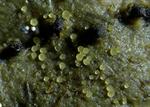
Coll. 2016-01-20
© H. Bender | | | | | |
Coprotus glaucellus (Rehm) Kimbr., Amer. J. Bot., 54: 22 (1967).
Basionym Ascophanus glaucellus Rehm, Rabenh. Kryptog.-Fl., Pilze - Ascom., 1: 1086 (1895).
Diagnosis Apothecien meist zerstreut, sitzend, mit flach schüsselförmiger, zart berandeter, endlich etwas gewölbter Fruchtschweibe, weiss oder geib, 0,2–0,5 Millim. breit, fleischig. Schläuche keulig, oben abgestutzt, oft etwas gebogen, kaum gestielt, 40–50 µ lang, 8–12 µ breit, 8sporig. Sporen eiförmig oder elliptisch, stumpf, glatt, einzellig, farblos, 6–9 µ lang, 3,5–4,5 µ breit, zweireihig liegend. Paraphysen unten gabelig ästig, septirt, ca. 1,5 µ breit, oben hakig gebogen und 2,5 µ breit, farblos oder schwach gelbröthlich.
Auf Wildkoth in den Waldungen bei Sugenheim in Franken, bei Nossen in Sachsen (Krieger).
Type ?
MycoBank 328889
Literature
Cacialli G., Caroti V., Doveri F. 1996. Contribución al estudio de los hongos coprófilos en Italia. XVI. Discomycetes: El género Coprotus. Boletín de la Sociedad Micológica de Madrid, 21: 113-125.
Kimbrough J.W. 1967. Studies in the Pseudoascoboleae. Canadian journal of botany, 44: 685-704.
Kimbrough J.W., Korf R.P. 1967. A synopsis of the genera and species of the tribe Theleboleae (=Pseudoascoboleae). American Journal of Botany, 54 (1): 9-23.
Kimbrough J.W., Luck-Allen E.R., Cain R.F. 1972. North American species of Coprotus (Thelebolaceae: Pezizales). Canadian journal of botany, 50 (5): 957-971.
Prokhorov V. 1998. The genera Coprotus, Ascozonus, Thelebolus and Trichobolus (Pezizales): The keys to the identification of species. Mikologia i Fitopatologia, 32: 40-43.
Van Vooren N. 2014. Contribution à la connaissance des Pézizales (Ascomycota) de Rhône-Alpes – 1re partie. Cahiers de la FMBDS, 3: 1-148.
Classification: Coprotaceae, Coprotus
Created on 25/02/2019.
Updated on 11/08/2023.
